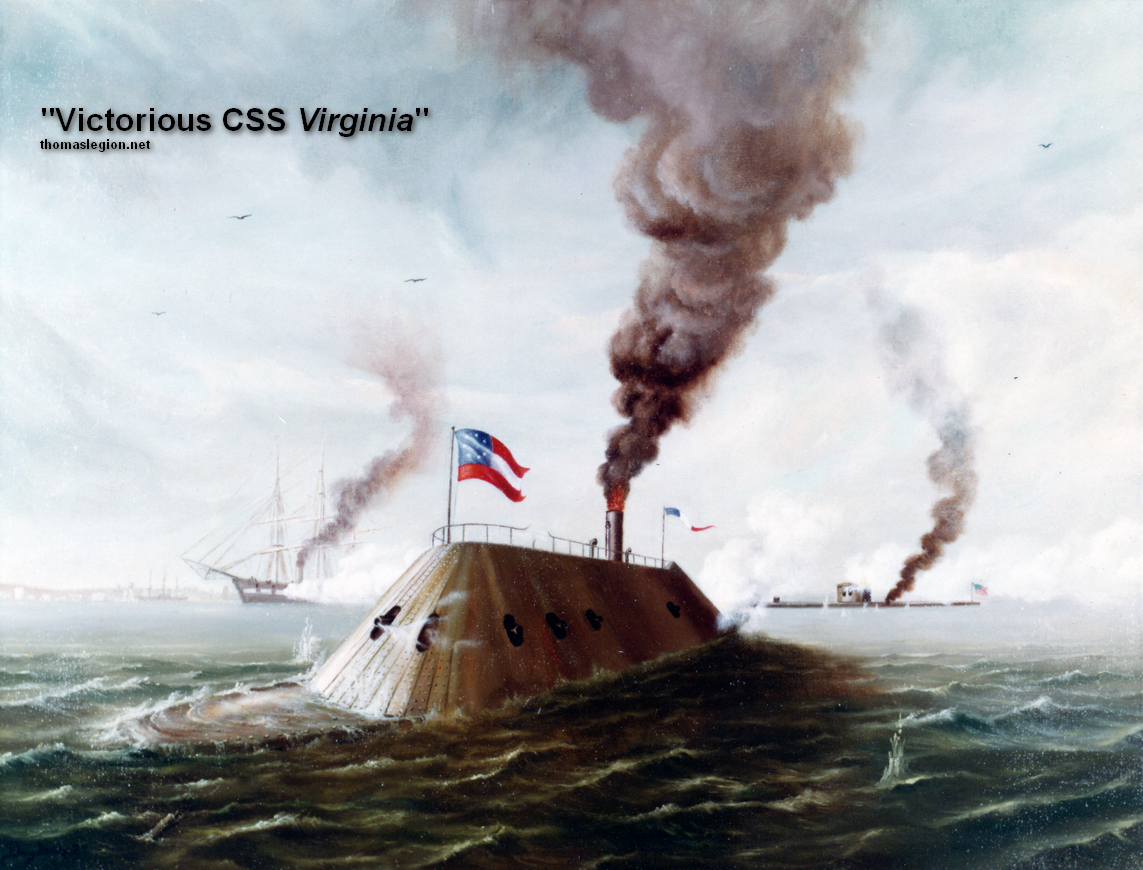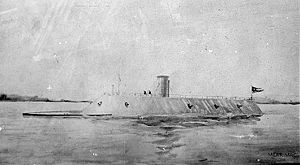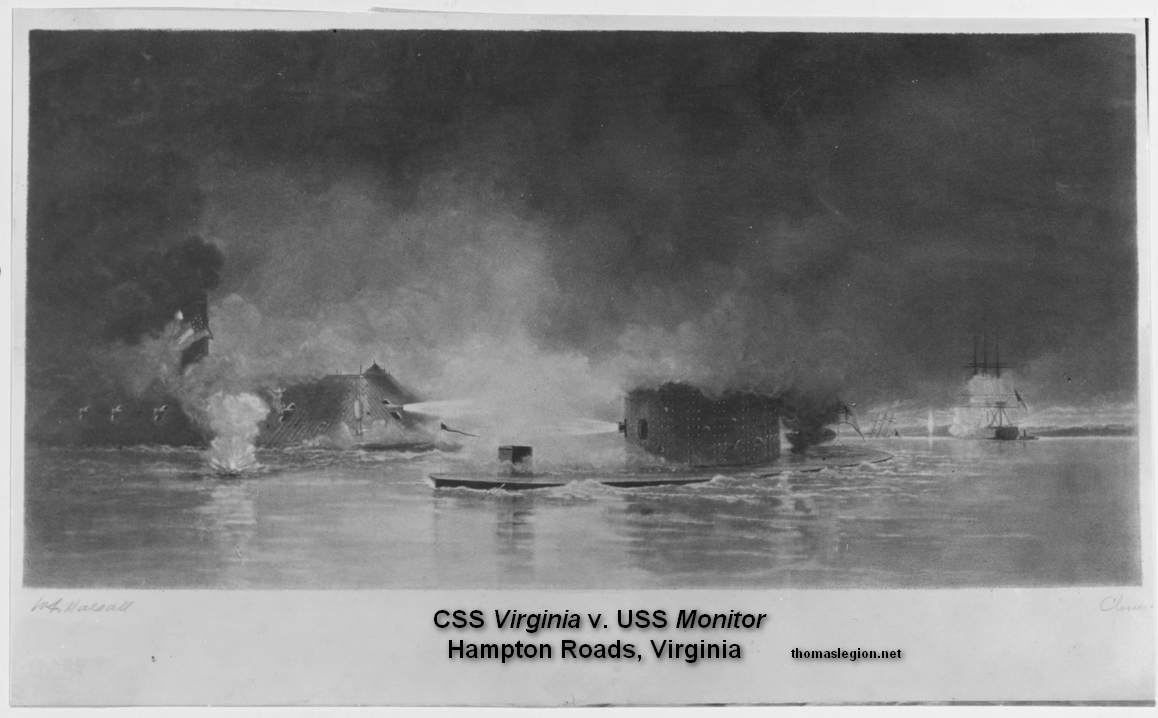|
USS Merrimack
History
Ironclad CSS Virginia Homepage
Ex-Union Warship Merrimack
Casemate Ironclad CSS Virginia Homepage
Introduction
The March 9, 1862, battle between the Monitor and the Merrimack (CSS Virginia)
during the American Civil War (1861-1865) was history’s first duel between ironclad warships. The engagement, known
as the Battle of Hampton Roads, was part of a Confederate effort to break the Union blockade of Southern ports, including
Norfolk and Richmond, Virginia, that had been imposed at the start of the war. Though the battle itself was inconclusive,
it began a new era in naval warfare. The fight made every navy worldwide obsolete, because the age of the battleship had just
arrived.
| Union Merrimack and Confederate Virginia |

|
| CSS Virginia at Battle of Hampton Roads |
From Union Frigate to Confederate Ironclad
During the Civil War, the Confederacy attempted to redress an imbalance
in firepower and resources by investing in technology. One element of this program involved the protection of Confederate
warships with iron plating. When Union naval officials learned that Southern shipwrights had converted the scuttled steam
frigate USS Merrimack into the ironclad CSS Virginia they feared that this powerful vessel might be able to break the Union
blockade at Norfolk, and bombard Fort Monroe or even steam up the Potomac River and threaten Washington, D.C.
By mid-1861, the North desperately needed ships to counter the Confederate
ironclad, and on August 3, 1861, Congress authorized a board of naval officers to inquire into the construction of armored
vessels. One of the most unconventional ship designs proposed to the United States Navy was by John Ericsson, and his vessel
featured the shallowest draft and shortest estimated completion time of all the other projected models. Ericsson's design,
however, met with great skepticism. The vessel would have an extremely low freeboard, turret-mounted guns, laminated iron
plates, and relied completely on steam power. The ship's quick construction time, however, was the key factor in the
Navy's decision to build from Ericsson's design.
Named the USS Monitor, John Ericsson's vessel illustrated the industrial
growth of the United States during the 19th century. The ship was built by teams of inventors, mechanics, and engineers, and
though these individuals were intimately associated with technological change, they were generally self-taught and worked
without the benefit of a strong theoretical background. The 172 ft long Monitor, completed by February 1862, featured a revolving
iron turret that was 22 ft in diameter, 9 ft high, and weighing 140 tons. On March 6, after completing its sea trials, the
new vessel was towed from Brooklyn, New York to join the blockading squadron off Virginia.
On March 9, 1862, the Monitor engaged the CSS Virginia in the historic Battle
of Hampton Roads. While the skirmish itself was a draw and neither vessel was seriously damaged, the Monitor played a significant
role in maintaining Union control over this key Southern port. More important, the battle caused American naval strategists
to question their reliance on wooden warships. In addition, the revolving turret and protective armor belt, made famous by
the Monitor, became standard features on latter generations of battleships.
On December 31, 1862, nature not cannon fire overpowered the Monitor. While
being towed to Charleston, South Carolina by the USS Rhode Island, the Monitor sank during a large storm off the coast of
Cape Hatteras, North Carolina.
| First Battle of the Ironclads |

|
| Monitor v. Merrimack |
| USS Merrimack and CSS Virginia |

|
| CSS Virginia Characteristics |
(About) "The Monitor and Merrimac: The First Fight Between Ironclads", a
chromolithograph of the Battle of Hampton Roads, produced by Louis Prang & Co., Boston. Signed "Jo Davidson." Merrimac,
which was actually the name of another Union vessel, remained a common yet popular misspelling of the ironclad Merrimack. Image
courtesy Library of Congress.
USS Merrimack Rechristened the CSS Virginia
The CSS Virginia was originally the USS Merrimack, a 40-gun frigate
launched in 1855. The Merrimack served in the Caribbean and was the flagship of the Pacific fleet in the late 1850s. In early
1860, the ship was decommissioned for extensive repairs at the Gosport Navy Yard in Norfolk, Virginia. The vessel was still
there when the Civil War began in April 1861, and Union sailors sank the ship as the yard was evacuated. Six weeks later,
a salvage company raised the ship and the Confederates began rebuilding it. The
Confederates covered the ship in heavy armor plating above the waterline and outfitted it with powerful guns. Rechristened
the Virginia, it was a formidable vessel when launched in February 1862. On March 8, the Virginia sunk two Union ships and
ran one aground off Hampton Roads in southeastern Virginia.
Battle of Hampton Roads on March 9, 1862
The next day, the USS Monitor steamed into the Chesapeake Bay. Designed by Swedish engineer John Ericsson,
the vessel had an unusually low profile, rising from the water only 18 inches. The flat iron deck had a 20-foot cylindrical
turret rising from the middle of the ship; the turret housed two 11-inch Dahlgren guns. The Monitor had a draft of less than
11 feet so it could operate in the shallow harbors and rivers of the South. It was commissioned on February 25, 1862, and
arrived at Chesapeake Bay just in time to engage the Virginia.
The
battle between the Virginia and the Monitor began on the morning of March 9 and continued for four hours. The ships circled
one another, jockeying for position as they fired their guns. However, the cannon balls simply deflected off the iron ships.
In the early afternoon, the Virginia pulled back to Norfolk. Neither ship was seriously damaged, but the Monitor effectively
ended the short reign of terror that the Confederate ironclad had brought to the Union navy.
Final Moments of the Monitor and the Merrimack
Both ships met ignominious ends. When the Federals invaded the James
Peninsula two months after the Battle of Hampton Roads, the retreating Confederates scuttled the Virginia. The Monitor went
down in bad weather off Cape Hatteras, North Carolina, at the end of the year. In 1973, the wreck of the Monitor was discovered
at the bottom of the Atlantic Ocean. Many artifacts from the vessel have since been recovered and are on display at the Mariners’
Museum in Newport News, Virginia. Though they had short lives, the two ironclads ushered in a new era in naval warfare.
| CSS Virginia (1862-1862) (ex USS Merrimack) |

|
| CSS Virginia (1862-1862) (ex USS Merrimack) |
USS Merrimack and CSS Virginia
| USS Merrimack (1856-1861) |

|
| USS Merrimack (1856-1861) |
CSS Virginia Officers and Key Personnel
Related Reading
| Battle of Hampton Roads |

|
| CSS Virginia battles USS Monitor |
(About) Battle between USS Monitor and CSS Virginia in Hampton Roads, Virginia,
9 March 1862. Lithograph by Closson Blake, after
a painting by W.F. Halsall, depicting the two ironclads engaging at close range. Collection of President Franklin D. Roosevelt.
U.S. Naval History and Heritage Command Photograph.
Recommended
Reading: Ironclad Down: USS Merrimack-CSS Virginia from Design to Destruction (Hardcover). Description: The result of more than fifteen years
of research, Ironclad Down is a treasure trove of detailed information about one of history s most famous vessels. Describing
the fascinating people--Stephen Russell Mallory, John Mercer Brooke, John Luke Porter, et al.--who conceived, designed and
built one of the world's first ironclads as well as describing the ship itself, Carl Park offers both the most thoroughly
detailed, in-depth analysis to date of the actual architecture of the Virginia
and a fascinating, colorful chapter of Civil War history.
Recommended
Reading: Confederate Ironclad vs Union Ironclad: Hampton Roads
1862 (Duel). Description: The Ironclad
was a revolutionary weapon of war. Although iron was used for protection in the Far East
during the 16th century, it was the 19th century and the American Civil War that heralded the first modern armored self-propelled
warships. With the parallel pressures of civil war and the industrial revolution, technology advanced at a breakneck speed.
It was the South who first utilized ironclads as they attempted to protect their ports from the Northern blockade. Impressed
with their superior resistance to fire and their ability to ram vulnerable wooden ships, the North began to develop its own
rival fleet of ironclads. Eventually these two products of this first modern arms race dueled at the battle of Hampton Roads
in a clash that would change the face of naval warfare. Continued below…
Fully illustrated
with cutting-edge digital artwork, rare photographs and first-person perspective gun sight views, this book allows the reader
to discover the revolutionary and radically different designs of the two rival Ironclads - the CSS Virginia and USS Monitor
- through an analysis of each ship's weaponry, ammunition and steerage. Compare the contrasting training of the crews and
re-live the horrors of the battle at sea in a war which split a nation, communities and even families. About the Author: Ron
Field is Head of History at the Cotswold School in
Bourton-on-the-Water. He was awarded a Fulbright Scholarship in 1982 and taught history at Piedmont
High School in California
from 1982 to 1983. He was associate editor of the Confederate Historical Society of Great Britain, from 1983 to 1992. He is
an internationally acknowledged expert on US Civil War military history, and was elected a Fellow of the Company of Military
Historians, based in Washington, DC,
in 2005. The author lives in Cheltenham, UK.
Recommended
Reading: The Battle of Hampton Roads: New Perspectives on the USS Monitor and the CSS Virginia (Mariner's Museum). Description: On March 8 and 9, 1862, a sea
battle off the Virginia coast changed naval warfare forever.
It began when the Confederate States Navy’s CSS Virginia led a task force to break the Union blockade of Hampton Roads.
The Virginia sank the USS Cumberland and forced the frigate
Congress to surrender. Damaged by shore batteries, the Virginia
retreated, returning the next day to find her way blocked by the newly arrived USS Monitor. The clash of ironclads was underway.
Continued below…
After fighting
for nine hours, both ships withdrew, neither seriously damaged, with both sides claiming victory. Although the battle may
have been a draw and the Monitor sank in a storm later that year, this first encounter between powered, ironclad warships
spelled the end of wooden warships—and the dawn of a new navy. This book takes a new look at this historic battle. The
ten original essays, written by leading historians, explore every aspect of the battle—from the building of the warships
and life aboard these “iron coffins” to tactics, strategy, and the debates about who really won the battle of
Hampton Roads. Co-published with The Mariners’ Museum, home to the USS Monitor Center, this authoritative guide to the
military, political, technological, and cultural dimensions of this historic battle also features a portfolio of classic lithographs,
drawings, and paintings. Harold Holzer is one of the country’s leading experts on the Civil War.
Recommended
Reading: A History of Ironclads: The Power of Iron over Wood. Description: This
landmark book documents the dramatic history of Civil War ironclads and reveals how ironclad warships revolutionized naval
warfare. Author John V. Quarstein explores in depth the impact of ironclads during the Civil War and their colossal effect
on naval history. The Battle of Hampton Roads was one of history's greatest naval engagements. Over the course of two days
in March 1862, this Civil War conflict decided the fate of all the world's navies. It was the first battle between ironclad
warships, and the 25,000 sailors, soldiers and civilians who witnessed the battle vividly understood what history would soon
confirm: wars waged on the seas would never be the same. Continued below…
About the Author: John V. Quarstein is an award-winning author and historian. He is director
of the Virginia
War Museum in Newport News and chief historical advisor for The Mariners' Museum's new USS Monitor Center
(opened March 2007). Quarstein has authored eleven books and dozens of articles on American, military and Civil War history,
and has appeared in documentaries for PBS, BBC, The History Channel and Discovery Channel.
Recommended
Reading: Iron Afloat:
The Story of the Confederate Armorclads.
Description: William N. Still's book is rightfully referred to as the standard of Confederate Naval history. Accurate and
objective accounts of the major and even minor engagements with Union forces are combined with extensive background information.
This edition has an enlarged section of historical drawings and sketches. Mr. Still explains the political background that
gave rise to the Confederate Ironclad program and his research is impeccable. An exhaustive literature listing rounds out
this excellent book. While strictly scientific, the inclusion of historical eyewitness accounts and the always fluent style
make this book a joy to read. This book is a great starting point.
Recommended
Reading: Gray Raiders of the Sea: How Eight Confederate Warships Destroyed the Union's High
Seas Commerce. Reader’s Review:
This subject is one of the most fascinating in the history of sea power, and the general public has needed a reliable single-volume
reference on it for some time. The story of the eight Confederate privateers and their attempt to bring Union trade to a halt
seems to break every rule of common sense. How could so few be so successful against so many? The United
States, after Great Britain,
had the most valuable and extensive import/export trade in the world by the middle of the 19th century. The British themselves
were worried since they were in danger of being surpassed in the same manner that their own sea traders had surpassed the
Dutch early in the 18th century. Continued below…
From its founding
in 1861, the Confederate States of America realized it had a huge problem since it lacked a navy.
It also saw that it couldn't build one, especially after the fall of its biggest port, New
Orleans, in 1862. The vast majority of shipbuilders and men with maritime skills lived north of the
Mason-Dixon Line, in the United States, and mostly in New
England. This put an incredible burden on the Confederate Secretary of the Navy, Stephen R. Mallory. When he saw
that most of the enemy navy was being used to blockade the thousands of miles of Confederate coasts, however, he saw an opportunity
for the use of privateers. Mallory sent Archibald Bulloch, a Georgian and the future maternal grandfather of Theodore Roosevelt,
to England to purchase British-made vessels
that the Confederacy could send out to prey on Union merchant ships. Bulloch's long experience with the sea enabled him to
buy good ships, including the vessels that became the most feared of the Confederate privateers - the Alabama,
the Florida, and the Shenandoah. Matthew Fontaine Maury
added the British-built Georgia, and the Confederacy itself launched the
Sumter, the Nashville, the Tallahassee,
and the Chickamauga - though these were generally not as effective
commerce raiders as the first four. This popular history details the history of the eight vessels in question, and gives detailed
biographical information on their captains, officers, and crews. The author relates the careers of Raphael Semmes, John Newland
Maffitt, Charles Manigault Morris, James Iredell Waddell, Charles W. Read, and others with great enthusiasm. "Gray Raiders"
is a great basic introduction to the privateers of the Confederacy. More than eighty black and white illustrations help the
reader to visualize their dramatic exploits, and an appendix lists all the captured vessels. I highly recommend it to everyone
interested in the Confederacy, and also to all naval and military history lovers.
Recommended
Viewing: The First Ironclads - Into the Modern Era (DVD) (2008). Description: This is the story of the great vessels, the formidable
warships, the epic ironclads (early battleships), that changed forever naval ship design as well as naval warfare: the Monitor,
the Merrimack
(later renamed the Virginia)
and it presents a fascinating animated reconstruction of their epic battle during the American Civil War. Continued below...
The Battle
of Hampton Roads, aka Duel of the Ironclads, which made the world's navies tremble as well as obsolete, is handsomely depicted
in this video. The First Ironclads – Into the Modern Era is a welcome addition for the individual interested in the
Civil War, U.S. Naval Warfare, and shipbuilding and design. It also includes footage from aboard the world's most devastating
“sailing ironship” the HMS Warrior.
|

